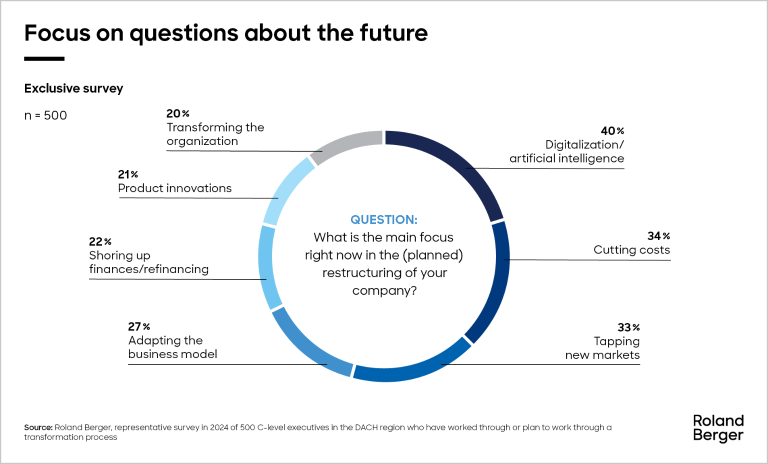Roland Berger is the partner of choice for strategic realignment, financial consolidation and operational excellence. Contact us now.


Transformational restructuring – A strategy to safeguard the future
By Alexander Müller and Adrian Pielken
How companies can keep a cap on costs without losing sight of the future
For company bosses, the only constant these days is relentless change. While juggling multiple crises, they simultaneously have to find compelling responses to the transformational challenges of our day. Restructuring itself is thus moving up to a higher level: Our transformational restructuring strategy provides a balanced, workable answer to the ubiquitous pressure to change to which companies everywhere are currently exposed.

In a context increasingly shaped by rapid transformation, restructuring is no longer what it once was. Nor can it be: Resolving liquidity bottlenecks remains a top priority, but this alone is usually no longer enough to get a struggling firm back into the black without also making fundamental changes. On the contrary, restructuring must now double up as strategic transformation in order to give companies a sustainable future outlook. Our new study explores the background to this development, spells out the steps involved in future restructuring exercises, and outlines key success factors.
"The future belongs to those companies whose restructuring endeavors systematically transform both the top line and the business model even as they consistently reduce costs. Unless you have the courage to embrace strategic change, you will not be able to stay the course."
Businesses hit hard by the polycrisis
A combination of exceptional factors is the reason why, for example, Germany and its corporate players are suffering particularly badly from the current crisis. Alongside an ongoing recession, the country is also wrestling with profound structural growth issues. At the same time, high energy and labor costs are causing domestic providers to fall further and further behind in international competition. A shortage of skilled labor and a comparative lack of expertise in the fields of digitalization and artificial intelligence (AI) are likewise slowing the speed of technological transformation. These difficult conditions are further exacerbated by China’s aggressive expansion in many industries. In Germany, the latter is affecting the automotive and steel industries especially.
Survey of top managers: Three out of four feel threatened by upheavals
The pressure to transform is equally overwhelming in many other countries and in many other industries, too. Witness the findings of a recent representative survey of 500 C-level executives commissioned by Roland Berger and conducted by the opinion researchers at Civey: According to the survey, 73% of respondents feel that their companies are threatened – 42% of them seriously threatened – by structural upheavals and crises. The executives surveyed also stress that restructuring exercises must be more ambitious if their companies are to enjoy long-term survival prospects. For example, 56% of top managers believe that conventional, mostly cost-driven restructuring strategies are no longer sufficient to master the profound transformational challenges that lie ahead.
This finding dovetails with our strategy of transformational restructuring, which links cost-cutting measures to rigorous top-line management and the transformation of the business model. This approach makes restructuring exercises more complex, but also more sustainable.
"For companies struggling with acute earnings and liquidity problems, the list of what has to be reengineered has never been longer. Apart from the need to cut costs, these companies must renew their strategy, structure and operations. To stand still is to fall backward."
Building blocks and success factors in sustainable restructuring
Strategic topics are thus moving front and center in the context of restructuring. Restructuring must include a level of transformation that suitably adapts both the business model and the top line. Specifically, our transformational restructuring strategy centers around three building blocks:
First, it is as vital as ever to set about optimizing the company’s costs and balance sheet.
Second, the top line must be managed by modifying and improving the existing product portfolio as well as the quality of prices and margins. Doing this puts the company on a sound financial footing during the restructuring phase and leaves sufficient leeway to go ahead with transformation.
At the same time, the third building block involves strategically repositioning the company and pressing ahead with advancing innovation. This will, of necessity, lead to the complete or partial transformation of the business model.
Most executives have understood the signs of the times. Asked about what key future issues are a major focus of current or planned restructuring exercises, 40% cite digitalization and artificial intelligence as their top priority. These topics are followed by conventional cost-cutting (34%), tapping new markets (33%), and adapting the business model (27%).
A word of caution is in order, though: However good the solution strategies outlined in the study may be, they will fall short of their full potential impact – or perhaps even fail entirely – if they are not properly fleshed out and anchored within the company, and if they do not have the full backing of actors and stakeholders alike. Above and beyond the traditional tools of the restructuring trade, other success factors that make a crucial difference include clearly defining the company’s strategic goals and formulating a target scenario for the whole organization. Getting staff to buy into the project is another important element of the transformation and restructuring process, as they are the central drivers and multipliers of change in practice.
Lastly, successful implementation hinges on having managers who can make decisions and get things done. These are the people who give external and internal stakeholders the sense of stability they need while change is in progress. Their resolute leadership keeps customers from jumping ship and keeps the company on a clear course. That is why managers with experience and the right strategic skills are essential to the turnaround process. They must also possess the determination, adaptability, and communication skills that are needed to navigate the organization through uncertain times.
Ultimately, what matters is for the measures outlined above to take root in the company with the backing and blessing of the various stakeholders. To get to this point, management must chart a clear strategic course – and must then implement it resolutely. As restructuring exercises grow progressively more complex, it can also be extremely helpful to have turnaround experience anchored in the management team. Especially in the context of crisis, it is vital to prepare the workforce for change and get them to buy into the transformation. It must be made clear that the measures have been weighed carefully and constitute the best way to safeguard the company’s future viability. Surprisingly, our survey found that only 15% of managers see communication as important to the success of restructuring. We believe that this figure vastly underestimates its true significance.
Register now to access our full publication “Why we need to rethink restructuring”. Furthermore, you will automatically receive our spotlight topics and regular news.







